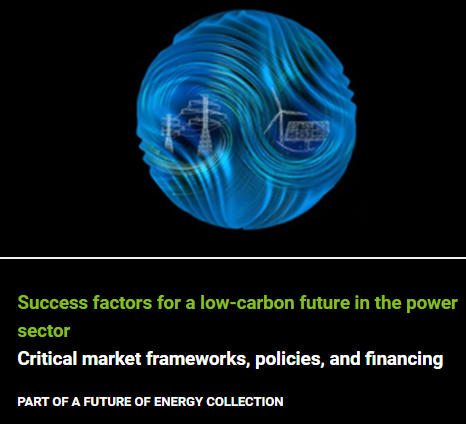While the medium- to long-term benefits in moving to a lower-carbon energy system outweigh the costs of the transition, in the short run, the design of energy policies should fairly spread the costs of tackling and adapting to climate change.
Renewables are set to account for 95% of the net increase in global power capacity between now and 2025. That growth is due to rising investor interest, the technology competitiveness of renewable technologies vis-à-vis conventional sources, creative financing models, and active policymaking at both the global and local level. In addition, demand-side pressures are also encouraging governments and companies to take greater action in facilitating the energy transition. In this report, we explore factors to accelerate the low-carbon future for the power sector, including the policies that can best support this objective, new financing mechanisms to expedite commercialisation of new technologies, and technologies that may most quickly address the challenges of intermittency.
Who should read this report?
C-suite executives and business leaders in the power, utilities, and renewables sector
Public sector professionals involved in energy policy
Recommended discussion points
Moving to a lower-carbon energy system presents a tremendous challenge, but several success factors can accelerate the transition towards a low-carbon future:
|
1 |
Laying the policy groundwork
Governments and multi-lateral institutions have a key role in facilitating the energy transition as “market maker” to support development of new technologies, and in establishing a policy framework to mitigate risks – including both price risks and regulatory risks – that may impact private capital investing in new business models. Given the breadth of policy activity worldwide, examples of such policy successes are often specific to the system and market in which they are implemented. |
|
2 |
Acknowledging the challenges
Policy efforts – including those relating to carbon taxes and emissions trading, retirement of fossil generation, and incorporation of market mechanisms – may be confounded by regional specifics or complexities, in which a policy that suits one sector or market is not easily implemented in another. |
|
3 |
Understanding the finance-policy link
The role of successful policy should be to mitigate the risks investors face, drive towards sustainability, and ensure a safe energy supply. With the private sector’s appetite for investment depending in part on the predictability and stability of policy over the long-term, subsidies or incentives are one way in which policies can influence project costs and shape investment strategies. |
|
4 |
The need for creative financing
Policies can help engender creative financing needed to address gaps in the market. Examples include community-based funding, crowdfunding of renewables, cross-border cooperation and financing, technology agnostic funding, and a contracts for difference (CfDs) auction model. |
|
5 |
Technologies to achieve the energy transition
Although wind and solar installations are certainly the public face of renewables, the future of the energy sector may depend on a widening mix of other technologies – including those related to storage, hybridisation, carbon capture, green hydrogen, and digitalisation – to adjust to intermittent renewable generation. |
Vietnam’s policy initiatives for a lower-carbon future
In Vietnam, the government has successfully implemented a system to encourage private partnership via creation of a power purchase agreement designed specifically to help multinational corporations operating in the country reduce their carbon footprint and meet their sustainability goals.
The government has also worked with USAID to establish two Vietnam Low Emission Energy Programs (V-LEEP I and V-LEEP II). Initiated in 2020, V-LEEP II aims to help design, finance, build, and operate 2,000 megawatts (MW) of renewable energy sources and is expected to advance Vietnam’s clean energy transition in four ways through 2025:
Deploy advanced clean energy systems by mobilising private sector investment
Improve energy sector performance, specifically renewable energy integration and dispatch
Increase competition in a market-based energy sector
Foster innovation, incubation, and inclusion in the energy sector

